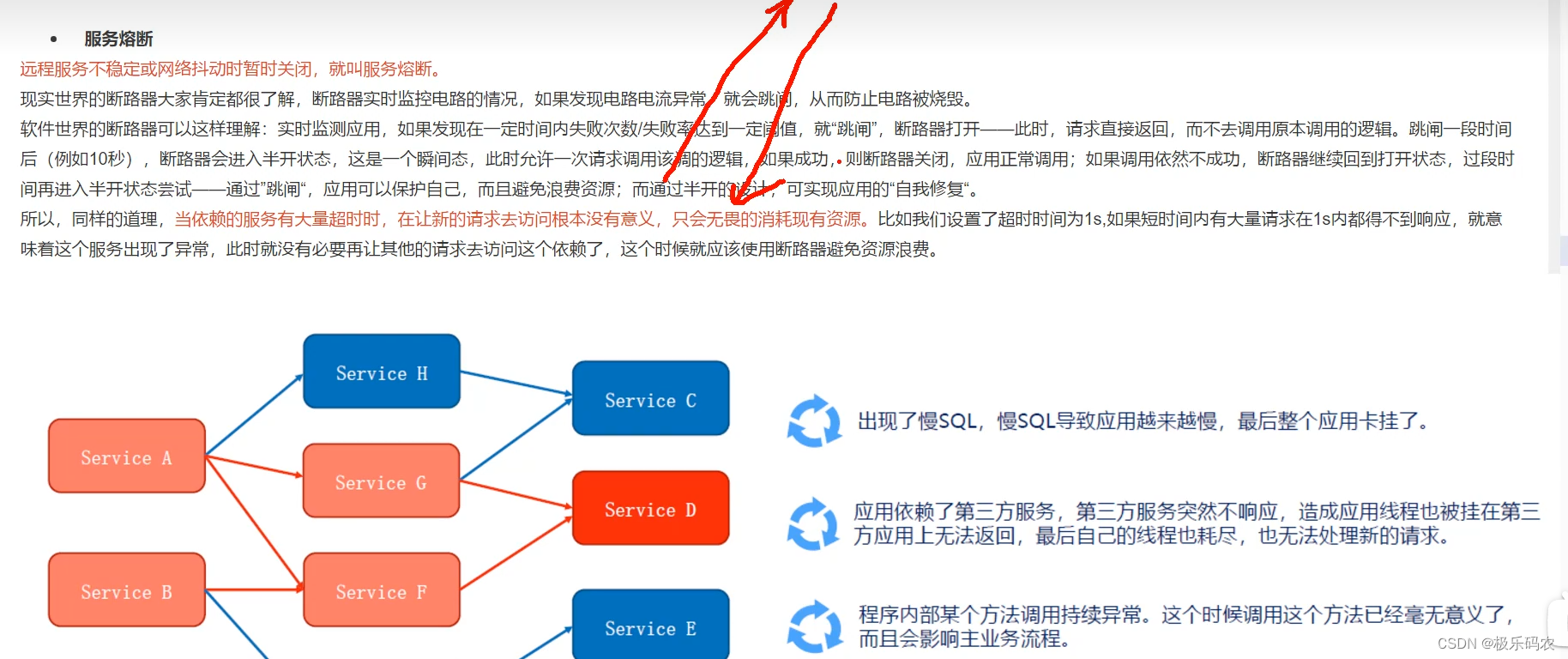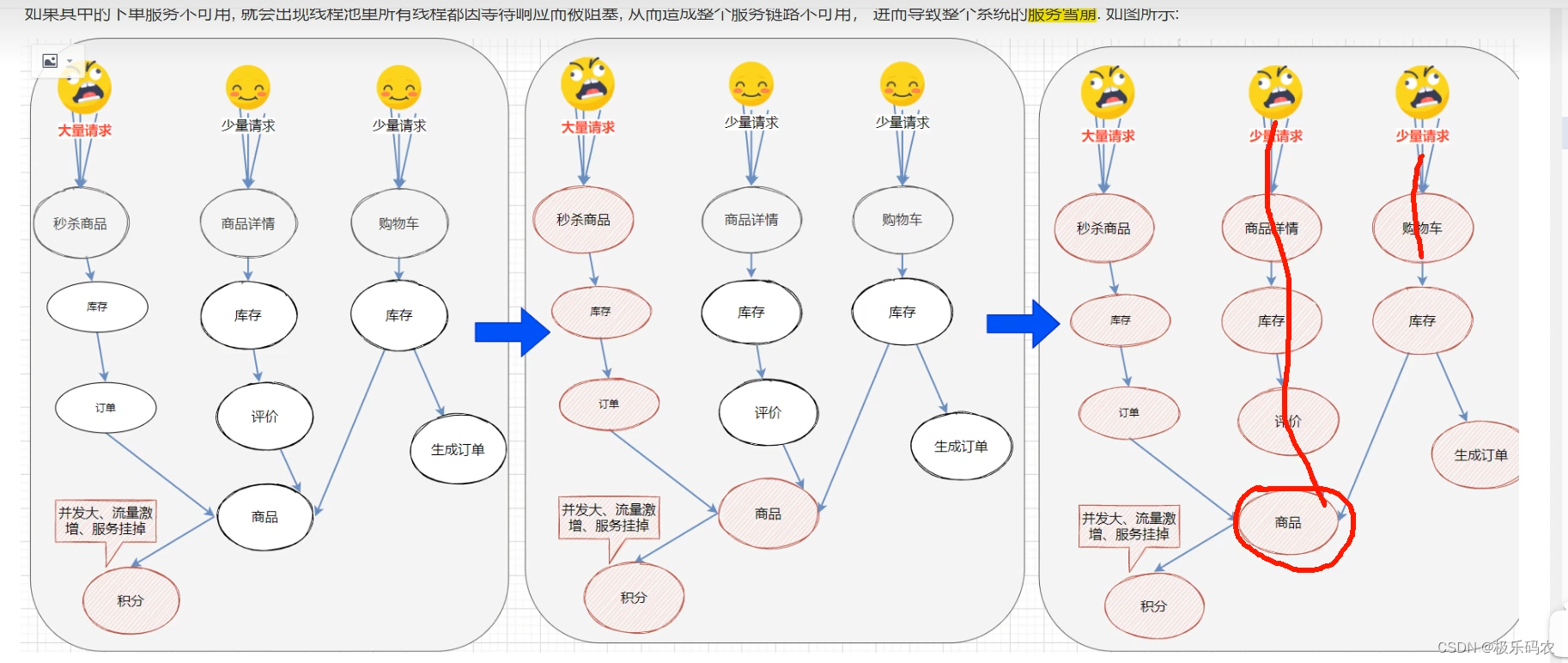sentinel组件学习
- sentinel学习
- sentinel容错机制
- 使用代码方式进行QPS流控-流控规则初体验
- 使用@SentinelResource注解进行流控
- 使用注解方式
sentinel学习
- 服务雪崩
服务雪崩效应:因服务提供者的不可用导致服务调用者的不可用,并将不可用逐渐放大的过程。
sentinel容错机制
常见的容错机制有超时机制、服务限流、隔离、服务熔断
- 超时机制
在不做任何处理的情况下,服务提供者不可用回导致消费者请求线程强制等待,而造成系统资源耗尽。加入超时机制,一旦超时,就释放资源。由于释放资源较快,一定程度上可以抑制资源耗尽的问题。 - 服务限流
某个服务达到QPS设定最大值则抛异常。 - 服务熔断

- 服务降级
有服务熔断,必然要有服务降级。
所谓降级,就是当某个服务熔断之后,服务将不再被调用,此时客户端可以自己准备一个本地的fellback(回退),回调,返回一个缺省值。例如:(备用接口/缓存/mock数据),这样做,虽然服务水平下降,但好歹可用,比直接挂掉要强,当然这也要看适合的业务场景。(服务熔断之后进入客户端降级方法)
使用代码方式进行QPS流控-流控规则初体验
- 引入sentinel相关包
<dependencies><dependency><groupId>org.springframework.boot</groupId><artifactId>spring-boot-starter-web</artifactId></dependency><!--sentinel核心库--><dependency><groupId>com.alibaba.csp</groupId><artifactId>sentinel-core</artifactId><version>1.8.0</version></dependency><dependency><groupId>org.projectlombok</groupId><artifactId>lombok</artifactId></dependency><dependency><groupId>com.alibaba.csp</groupId><artifactId>sentinel-annotation-aspectj</artifactId><version>1.8.0</version></dependency><dependency><groupId>junit</groupId><artifactId>junit</artifactId><version>3.8.1</version><scope>test</scope></dependency></dependencies>
- 代码实现
package com.sentinel.controller;import com.alibaba.csp.sentinel.Entry;
import com.alibaba.csp.sentinel.SphU;
import com.alibaba.csp.sentinel.Tracer;
import com.alibaba.csp.sentinel.slots.block.BlockException;
import com.alibaba.csp.sentinel.slots.block.RuleConstant;
import com.alibaba.csp.sentinel.slots.block.flow.FlowRule;
import com.alibaba.csp.sentinel.slots.block.flow.FlowRuleManager;
import lombok.extern.slf4j.Slf4j;
import org.springframework.web.bind.annotation.RequestMapping;
import org.springframework.web.bind.annotation.RestController;import javax.annotation.PostConstruct;
import java.util.ArrayList;
import java.util.List;/*** @author : zhouzhiqiang* @date : 2024/6/5 23:25* @description :*/
@Slf4j
@RestController
@RequestMapping("/hello")
public class HelloController {private static final String RESOURCE_NAME="hello";private static final String USER_RESOURCE_NAME="user";private static final String DEGRADE_RESOURCE_NAME="degrade";@RequestMapping("/helloSentinel")public String hello(){Entry entry=null;try {entry= SphU.entry(RESOURCE_NAME);String str="hello world";log.info("======="+str+"=======");return str;} catch (BlockException e) {log.info("block");return "被限流了!";}catch (Exception e){Tracer.traceEntry(e,entry);}finally {if (entry != null) {entry.exit();}}return null;}@PostConstructpublic static void initFlowRules(){//流控规则List<FlowRule> rules=new ArrayList<>();//流控FlowRule rule = new FlowRule();//为哪个资源进行流量控制rule.setResource(RESOURCE_NAME);rule.setGrade(RuleConstant.FLOW_GRADE_QPS);rule.setCount(1);rules.add(rule);//加载流控规则FlowRuleManager.loadRules(rules);}
}
使用@SentinelResource注解进行流控
要使用这个注解需要引入相关包和配置SentinelResourceAspect的bean
- 引入包
<dependency><groupId>com.alibaba.csp</groupId><artifactId>sentinel-annotation-aspectj</artifactId><version>1.8.0</version></dependency>
- 配置bean
@Beanpublic SentinelResourceAspect sentinelResourceAspect(){return new SentinelResourceAspect();}
使用注解方式
value:定义资源(接口名称)
blockHandler :设置流控降级后的处理方法,默认该方法,必须声明在一个类中
fallback:接口中出现异常了,就可以交给fellback指定的处理方法
@PostConstructpublic static void initFlowRules(){//流控规则List<FlowRule> rules=new ArrayList<>();//流控FlowRule rule = new FlowRule();//为哪个资源进行流量控制rule.setResource(USER_RESOURCE_NAME);rule.setGrade(RuleConstant.FLOW_GRADE_QPS);rule.setCount(1);rules.add(rule);//加载流控规则FlowRuleManager.loadRules(rules);}@RequestMapping("/user")@SentinelResource(value = USER_RESOURCE_NAME,blockHandler = "blockHandlerForGetUser",fallback = )public User getUser(String id){return new User("zzq");}/*** 注意:* 1、一定是public* 2、返回值一定得和原方法返回值一致,包含方法的参数* 3、可以在参数的最后添加BlockException,可以区分是什么规则的处理方法* @param id* @param e* @return*///降级方法public User blockHandlerForGetUser(String id,BlockException e){e.printStackTrace();return new User("被流控了!");}













![[数据集][目标检测]道路圆石墩检测数据集VOC+YOLO格式461张1类别](http://pic.xiahunao.cn/[数据集][目标检测]道路圆石墩检测数据集VOC+YOLO格式461张1类别)





)
